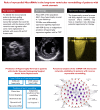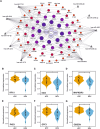Role of myocardial microRNAs in the long-term ventricular remodelling of patients with aortic stenosis
- PMID: 39131907
- PMCID: PMC11311707
- DOI: 10.1093/ehjopen/oeae060
Role of myocardial microRNAs in the long-term ventricular remodelling of patients with aortic stenosis
Abstract
Aims: We hypothesize that miRs are key players in the dynamics of the hypertrophy phenotype in aortic stenosis (AS) patients. In our study, we aimed to identify the transcriptional patterns (protein-coding transcripts and miRs) from myocardial sample biopsies that could be associated with the absence of left ventricular (LV) mass regression after aortic valve replacement (AVR) in patients with severe AS and LV hypertrophy.
Methods and results: We prospectively included 40 patients with severe AS, LV hypertrophy, and preserved ejection fraction undergoing AVR. Myocardial biopsies obtained during surgery were analysed for transcriptomic analysis performed by next-generation sequencing. At a 1-year follow-up, no hypertrophy reversal was observed in about half of the patients in the absence of patient-prosthesis mismatch and prosthesis dysfunction of uncontrolled hypertension. Predictors of mass regression were assessed from clinical, echocardiographic, and biochemical variables as well as from 300 miRs obtained from myocardial specimens, allowing the identification 29 differentially expressed. miR-4709-3p was found as a positive independent predictor of hypertrophy regression together with high-sensitivity troponin T (cTNT-hs) as a negative predictor. Gene transcripts RFX1, SIX5, MAPK8IF3, and PKD1 were predicted as simultaneous targets of five upregulated miRs suggesting its importance in LV hypertrophy.
Conclusion: In our cohort, tissue miR-4709-3p and cTNT-hs were independent predictors of hypertrophy regression. The hypertrophy reversal process will likely depend from a complex network where miRNAs may have an important role, allowing a potential opportunity for therapy.
Keywords: Aortic stenosis; Cardiac remodelling; MicroRNA; Prognosis.
© The Author(s) 2024. Published by Oxford University Press on behalf of the European Society of Cardiology.
Conflict of interest statement
Conflict of interest: none declared.
Figures




Similar articles
-
Myocardial gene expression of microRNA-133a and myosin heavy and light chains, in conjunction with clinical parameters, predict regression of left ventricular hypertrophy after valve replacement in patients with aortic stenosis.Heart. 2011 Jul;97(14):1132-7. doi: 10.1136/hrt.2010.220418. Epub 2011 May 17. Heart. 2011. PMID: 21586423
-
Circulating levels of miR-133a predict the regression potential of left ventricular hypertrophy after valve replacement surgery in patients with aortic stenosis.J Am Heart Assoc. 2013 Aug 15;2(4):e000211. doi: 10.1161/JAHA.113.000211. J Am Heart Assoc. 2013. PMID: 23948643 Free PMC article.
-
Impact of Obesity on Persistent Left Ventricular Hypertrophy After Aortic Valve Replacement for Aortic Stenosis.Am J Cardiol. 2019 Mar 15;123(6):942-947. doi: 10.1016/j.amjcard.2018.12.012. Epub 2018 Dec 19. Am J Cardiol. 2019. PMID: 30654925 Clinical Trial.
-
Relevance of residual left ventricular hypertrophy after surgery for isolated aortic stenosis.Eur J Cardiothorac Surg. 2016 Mar;49(3):952-9. doi: 10.1093/ejcts/ezv240. Epub 2015 Jul 18. Eur J Cardiothorac Surg. 2016. PMID: 26188338
-
Associations of residual left ventricular and left atrial remodeling with clinical outcomes in patients after aortic valve replacement for severe aortic stenosis.J Cardiol. 2016 Sep;68(3):241-7. doi: 10.1016/j.jjcc.2015.09.017. Epub 2015 Oct 31. J Cardiol. 2016. PMID: 26527112
Cited by
-
MicroRNA-143-3p and miR-452-5p: A Fingerprint for the Diagnosis of Aortic Stenosis in the Geriatric Population.Biomedicines. 2025 Mar 10;13(3):671. doi: 10.3390/biomedicines13030671. Biomedicines. 2025. PMID: 40149647 Free PMC article.
-
Cardiomyopathies: The Role of Non-Coding RNAs.Noncoding RNA. 2024 Oct 23;10(6):53. doi: 10.3390/ncrna10060053. Noncoding RNA. 2024. PMID: 39449507 Free PMC article. Review.
References
LinkOut - more resources
Full Text Sources
Research Materials

